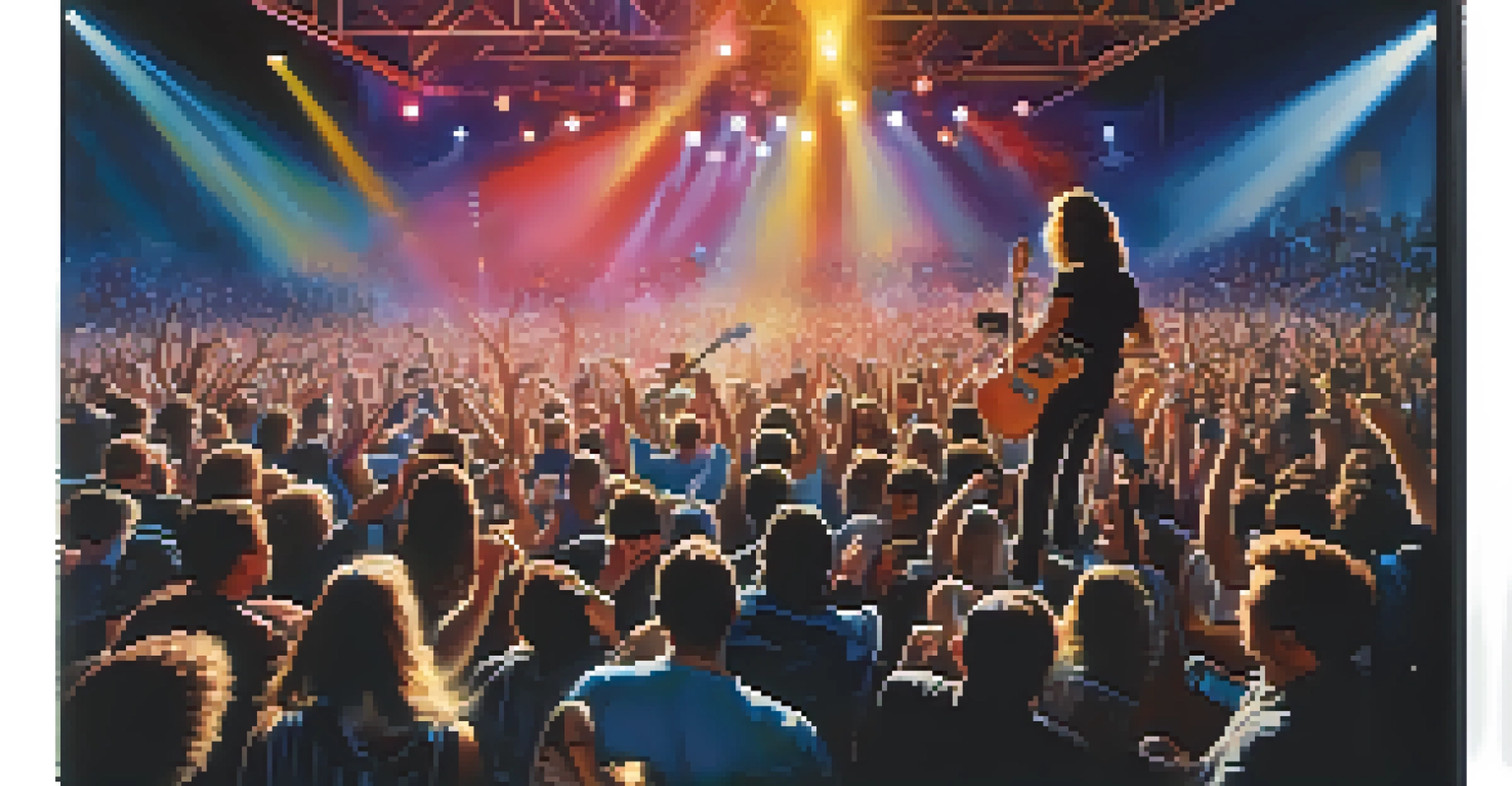Electric Guitar Revolution: From Jazz to Rock 'n' Roll

The Birth of the Electric Guitar: A New Era in Music
The electric guitar emerged in the 1930s, revolutionizing how music was created and performed. This innovative instrument allowed musicians to amplify their sound, making it possible to play louder and clearer in larger venues. The first widely recognized electric guitar was the Rickenbacker Frying Pan, which set the stage for a musical evolution that would soon captivate audiences everywhere.
The electric guitar is the instrument that can express the deepest emotions, from joy to sorrow, with just a single note.
Initially popular in jazz and swing bands, the electric guitar brought a new dimension to rhythm and melody. Artists like Charlie Christian showcased its potential, blending traditional jazz with this modern sound. As musicians explored its capabilities, they laid the groundwork for what was to come in the decades ahead.
Related Resource
The electric guitar's unique tone and versatility quickly made it a favorite among musicians. It wasn't long before this instrument found its way into other genres, leading to the diverse styles that would define the music landscape in the years to follow.
Jazz and the Electric Guitar: A Perfect Harmony
In the 1940s, jazz musicians embraced the electric guitar, using it to create intricate solos and rich harmonic textures. Players like Wes Montgomery and Barney Kessel pushed the boundaries, showcasing the guitar's ability to blend seamlessly with other instruments. Their innovative techniques inspired countless musicians, illustrating how the electric guitar could enhance the jazz genre.

The electric guitar's warm, resonant tones allowed jazz artists to experiment with new sounds and styles. The addition of effects like reverb and distortion opened up a world of creative possibilities. This experimentation laid the groundwork for future genres, making jazz a vital part of the electric guitar's journey.
Electric Guitar Revolutionized Music
The electric guitar emerged in the 1930s, changing how musicians created and performed across various genres.
As jazz evolved, so did the electric guitar, leading to the emergence of sub-genres like jazz fusion. This blend of jazz, rock, and other musical influences showcased the guitar's versatility, proving that it could be a driving force in any musical landscape.
The Rise of Rock 'n' Roll: Electric Guitar Takes Center Stage
The 1950s marked a monumental shift in music as rock 'n' roll exploded onto the scene, with the electric guitar taking center stage. Artists like Chuck Berry and Buddy Holly utilized the guitar to create catchy riffs and memorable melodies that defined the genre. Their energetic performances and innovative songwriting captured the imagination of a generation.
The guitar is a small orchestra. It is polyphonic. Every string is a different color, a different voice.
Guitarists began to adopt new playing styles, incorporating techniques such as fingerpicking and power chords. This shift not only influenced the sound of rock but also inspired a wave of young musicians to pick up the electric guitar. The instrument became a symbol of rebellion and creativity, resonating with the youth culture of the time.
Related Resource
As rock 'n' roll gained popularity, so did the electric guitar's status as a cultural icon. It paved the way for legendary bands like The Beatles and The Rolling Stones, who further pushed the envelope, solidifying the electric guitar's place in music history.
Innovations in Electric Guitar Technology
As the electric guitar gained popularity, manufacturers began to innovate, creating a variety of models and designs. From Fender's Stratocaster to Gibson's Les Paul, these guitars offered unique sounds and aesthetics that appealed to different musical styles. These innovations allowed musicians to express their individuality and explore new sonic territories.
Developments in technology also led to the introduction of solid-body guitars, which offered greater sustain and reduced feedback. This advancement made electric guitars more versatile, enabling players to experiment with various effects and sounds. As a result, the electric guitar became an essential tool for artists across genres, from rock to blues and beyond.
Jazz Embraced Guitar's Versatility
In the 1940s, jazz musicians utilized the electric guitar to create intricate solos and explore new harmonic possibilities.
The rise of guitar amplifiers and effects pedals further transformed the electric guitar landscape. Musicians could now manipulate their sound like never before, leading to the creation of iconic tones that defined countless songs. This ongoing evolution continues to shape how the electric guitar is used in contemporary music.
The Electric Guitar in Blues: A Soulful Connection
Blues music has been deeply intertwined with the electric guitar since its inception. Artists like B.B. King and Muddy Waters harnessed the instrument's emotional power, using it to convey feelings of heartache and triumph. Their soulful playing styles and unique approaches to the electric guitar elevated the genre, creating a lasting legacy.
The electric guitar allowed blues musicians to experiment with different techniques, such as bending notes and using vibrato. This expressive playing style resonated with audiences, showcasing the guitar's ability to convey raw emotion. As blues evolved, it influenced other genres, including rock, jazz, and even country, proving the electric guitar's versatility.
Related Resource
Today, the electric guitar continues to play a significant role in blues music, with contemporary artists drawing inspiration from the legends of the past. This connection underscores the enduring relationship between the electric guitar and the emotional depth of the blues.
The Electric Guitar's Impact on Pop Music
As pop music evolved, the electric guitar remained a crucial element in shaping its sound. From the catchy hooks of the 60s to the synth-infused tracks of the 80s, guitarists found innovative ways to incorporate this instrument into their music. Artists like Prince and Michael Jackson showcased the electric guitar's versatility, blending it with various genres to create unforgettable hits.
The electric guitar's ability to adapt to different styles made it a favorite among pop musicians. Whether used for a simple melody or complex solos, it added depth and character to countless songs. This adaptability ensured that the electric guitar remained relevant, even as musical trends shifted over the decades.
Electric Guitar Shaped Pop Trends
The electric guitar has remained a vital element in pop music, adapting to various styles and inspiring new generations of musicians.
Today, the electric guitar continues to thrive in pop music, inspiring new generations of musicians. Its enduring presence highlights the instrument's ability to transcend genres and connect with audiences across the globe.
The Future of the Electric Guitar: A New Musical Frontier
As we look to the future, the electric guitar continues to evolve, influenced by advancements in technology and changing musical landscapes. New genres, such as electronic and experimental music, are pushing the boundaries of what the electric guitar can achieve. Musicians are increasingly blending traditional guitar techniques with digital elements, creating innovative sounds that captivate audiences.
The rise of online platforms and social media has also transformed the way guitarists connect with one another. Musicians can share their work, collaborate, and learn from one another, fostering a global community that thrives on creativity. This accessibility encourages new talent and fresh ideas, ensuring that the electric guitar remains at the forefront of the music scene.

As we embrace this new musical frontier, the electric guitar's rich history and adaptability will undoubtedly continue to inspire and shape the future of music. Its journey from jazz to rock 'n' roll and beyond is a testament to the instrument's enduring legacy and its central role in the ever-evolving world of sound.